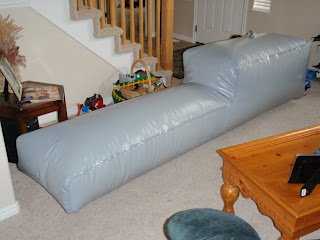This ballast system is for a 2003 Centurion Avalanche. The ballast system will be used primarily to create a surfing wave on the port side of the boat. However this particular set up can be easily modified to design a ballast system for the starboard side of the boat or for a more equally balanced ballast system for wakeboarding. The boat currently has no factory ballast system so I am basically starting from scratch on this one. If your boat has some hard tanks already installed the process can be much easier
My current surfing set up includes using 4 fat sac’s that I manually fill with pumps that are powered from the 12 volt accessory outlet. The current sac’s are 750# in port locker, 500# on rear seat toward port side, 175# under port seats, and 175# on port seats for a total of 1600#. It takes about 20 minutes to fill all these bags and other 20 minutes to empty them.
The new automated system will fill the new sacs with a push of 2 buttons on the switch panel and should both fill and empty in less than 10 minutes. The new system will utilize a custom made Flying High Pro X fat sac that is designed to completely fill the entire port locker and then continue forward under the port seats. The dimension and weight of the custom sac is as follows:
Main 22H X 24W X 52L
Arm 10H X 24W X 62L
Main… LXWXH = 27456 = 118.857 gallons = 992.46 pounds
Arm.. LXWXH = 14880 = 64.416 gallons = 537.87 pounds
Total cubic inches = 42336 = 183.272 gallons = 1530 pounds
*Water 8.35 pounds per gallon
I am using 2 reversible Johnson Ultra Ballast pumps (13.7 GPM) to both fill and empty the custom sac. I chose these pumps over the Jabsco Ballast Puppy pumps that flow at only 9 GPM. The advantage (which is controversial by those that prefer the aerator type pumps) of the reversible pump is that you can use the same hole in the bottom of the boat to both fill and drain the sacs. This means less holes in the boat!
There are many arguments over using an impeller type pump vs a aerator type. The aerators are cheaper, quieter, and draw less power. The impeller type are more heavy duty but noisier and draw a lot of power. If you want help choosing which is best for you, read this ballast thread... http://www.centurioncrew.com/Aerator-Pumps-and-Electric-t1970.html
This guy tests out the most common type of pump and incorporates different valves as well to see how they effect flow. Some really great hard core info here on pump and valve performance. This data came out after my install was done. I am glad I chose the Johnson pumps and did not utilize any sprinkler valves in the system.
For my water intake, I am using a 1 ¼ inch thru-hull scupper (brass) that will be installed in the bottom of the boat near the speed wheel and T handle floor drain. The 1 ¼ inch inlet/outlet should be sufficient to allow two 1” lines to be run (one to each pump) and allow the pumps plenty of water flow as to not be starved for water. The pumps themselves only have a 1/2” inlets/outlets and the fat sacs only have ¾ inch drain/fill holes. So there are other natural bottlenecks in the system other than the intake.
This ballast system will have two auxiliary fill hoses that will allow other auxiliary sacs to be filled when needed/wanted. These sacs can be placed on the rear seat, port seat, walk through, bow area, or floor area as needed. The two hoses can be pulled out of a compartment to fill/drain the aux sac and then disconnected from the sac and stowed in the compartment.
The custom sac will also have a vent/overflow drain. This will be connected by hose to a 1” stainless steel thru-hull vent on the port side of the boat and will utilize a one way (spring type) valve inline to prevent water from entering into the sac from lake. Once the sac is full this will overflow indicating that the pumps need to be turned off. This will also allow any excess air in the sac to be “burped” off. When emptying the sac the one way valve will not allow any air into the sac and it should raisin up as it drains which is nice to preserve storage space.
Schematic drawing of ballast system as well as an itemized list of plumbing supplies and their location in addition to how many of each are needed. *The sac’s are not to size or shape*.
Double click on any photo to enlarge it.

Drawing of the Custom Avy sac used to place the order

Picture of the custom Avy sac blown up with air. Its HUGE!!!








+%5B640x480%5D.JPG)





















